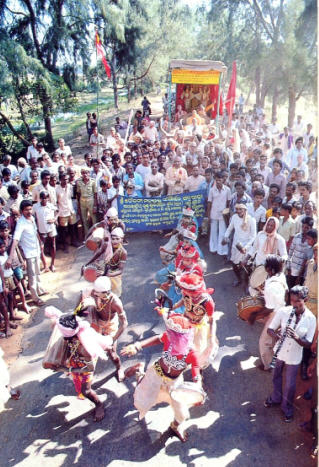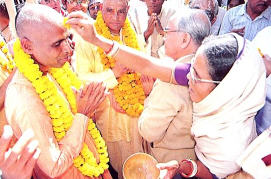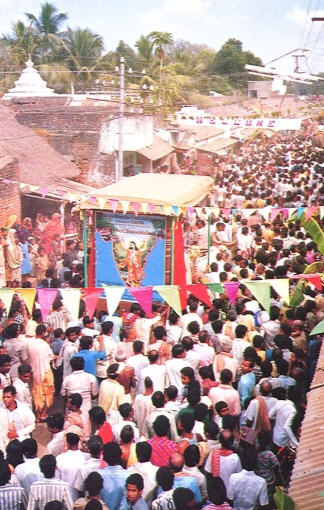Garlands, incense, elephants, jostling crowds,
thousands of cheering voices: pada-yatra a walking tour
of holy India arrives in the land of Lord Caitanya.
Nearly as much as France differs from Italy, Germany, or Greece, Orissa differs from the other states of India. It has its own language, its own food, its own customs and its own way of receiving the pada-yatra.

In the state of Kerala, South India, for example, as we walked into a town or village the people would receive us first with five musicians always five playing wooden drums and shenai. Following them would come a delegation of temple priests, chanting mantras in unison from the Vedas. Rows of young girls might line the roadside, bearing ghee lamps and tossing flower petals. Leading men would honor us with flower garlands. Sometimes temple elephants, foreheads shining with golden ornaments, would lumber forth to add more weight to the greeting.
But in Orissa, forget the elephants, forget the shenais, the orderly rows of petal-throwers. Here it's crowds five hundred people, a thousand, maybe two thousand or more and loud, exuberant chanting of the Hare Krsna maha-mantra: Hare Krsna, Hare Krsna, Krsna Krsna, Hare Hare/ Hare Rama, Hare Rama, Rama Rama, Hare Hare.
Right now I'm in the southern Orissan town of Kabisurya Nagar in a crowd of maybe two thousand people. And it's only two thousand because the pada-yatra has reached today's resting place an elementary school campus and the police have closed the gates behind us. But on our way into town the crowds must have come to twenty thousand: five or seven Hare Krsna chanting parties . . . streets all festooned . . . welcome gates of banana trees . . . auspicious waterpots topped with mango leaves outside the doorways of people's homes . . . people jostling forward to offer garlands, incense, coconuts, full stalks of banana . . . near-riots as we pull the bananas off the stalks to throw into the crowd and people jump, shout, grab, and tumble to get them . . . Ladies line the rooftops, oscillating their tongues to make a special high-pitched cheer of appreciation that sounds like "ulu-ulu-ulu-ulu-ulu."
Lord Caitanya Mahaprabhu, the original father of the Hare Krsna movement, spent six years traveling through south India but a full eighteen in Jagannatha Puri, the spiritual focal point of Orissa. So even today, five hundred years later, Orissa still feels Lord Caitanya's influence.

Lokanath Swami
In south India we had to tell people who Lord Caitanya was. Lord Caitanya, we said, was the Supreme Lord, Krsna Himself, the Personality of Godhead, descended on earth as a devotee of Krsna to teach devotional service and relish performing it Himself. And we had to offer evidence from Vedic scriptures to prove it. Lord Caitanya, we'd also explain, had taught that the best means of self-realization in the present age is the chanting of the Vedic maha-mantra: Hare Krsna, Hare Krsna, Krsna Krsna, Hare. Hare/ Hare Rama, Hare Rama, Rama Rama, Hare Hare.
But in Orissa, no need to tell all this. People, even common people, already know Lord Caitanya is God. They already worship Him. And they already chant the Hare Krsna maha-mantra.
As we walk along the road, we're greeted by kirtana (chanting) parties of 10, 20, 50, 150. They chant the Hare Krsna mantra with fervor, and above their heads they carry posters, tacked to bamboo poles, of Lord Caitanya Mahaprabhu dancing with His main companion. Lord Nityananda.
Yet for the most part these kirtana singers are not what we'd consider pure devotees. Some smell of fish and sugarcane liquor. And when the chanting is over we see singers and mrdanga drum players relaxing with a smoke.
Not good.
Chanting Hare Krsna can cleanse our hearts of all material dust and dirt. But tobacco, fish, and liquor just throw the dirt back on. To get the full effect of chanting we should chant under the guidance of a pure devotee of the Lord.
In Orissa, therefore, we make a special point of telling people about Lord Caitanya's most prominent modern emissary, His Divine Grace A.C. Bhaktivedanta Swami Prabhupada.
Though people know Gaura-Nitai (Lord Caitanya and Lord Nityananda), they don't yet know Srila Prabhupada. Often they've been awed to hear that some other swami, a hundred years ago, went to America bearing the torchlight of Vedic knowledge. They'd be let down to learn that the swami's mission in America was a fizzle: a hundred years later, not a single American had become Krsna's devotee, no one had adopted the Vedic culture, and today the swami and his teachings are still virtually unknown.

The real person who brought Vedic culture to the West was Srila Prabhupada. He is the one who has put more than five million copies of Bhagavad-gita in twenty-six languages into people's hands. It's by his efforts that thousands of Americans have become full-time devotees of Krsna. It is he who spread Krsna consciousness to Europe, Australia, Africa, Japan, and even Russia. The Krsna temples opened in the major cities of the West are his, and the Krsna devotees chanting Krsna's names in the streets of New York, Tokyo, and London are following him.
All this has been possible because Srila Prabhupada faithfully represented the message of Lord Sri Krsna, as taught by Lord Caitanya Mahaprabhu. In Bhagavad-gita Lord Krsna asks us, "Think of Me, become My devotee, worship Me, and offer your homage to Me." And Lord Caitanya showed us how to do this.
At Lord Caitanya's request, His most intimate followers explained, step by step, how to advance in Krsna consciousness. Although Lord Caitanya relished and revealed the highest sentiments of love of Godhead, what He taught was not a religion of sentimental fervor but a scientific process for developing love of Krsna. Love for Krsna, He taught, is dormant in the heart of everyone, and as we cleanse our hearts by properly hearing, chanting, and rendering devotional service, that love naturally reawakens.
In the villages and towns of Orissa, love for Krsna and Lord Caitanya is already astir but it still has sleep in its eyes. So as our pada-yatra travels we introduce people to Srila Prabhupada and give them his books, confident that the same powerful emissary who awakened Krsna consciousness in the West can here bathe it clean, fresh, and ready to go.
Lord Caitanya desired, "People fortunate enough to be born in India should perfect their lives by Krsna consciousness and spread it for the welfare of others." With Srila Prabhupada's guidance, the people here in Orissa, already pulled toward Lord Caitanya, can learn how to systematically follow His teachings, and Lord Caitanya's desire can be fulfilled.
